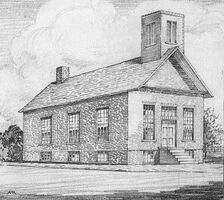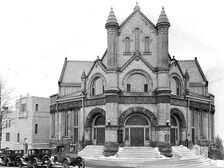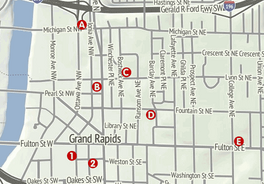No edit summary |
m (→Beginnings: added map with locations) |
||
| Line 6: | Line 6: | ||
<p class="p5">According to Daniel L. Ballast, who wrote a history of the congregation, First was created as part of the "Western Enterprise" of the Reformed Church, a program that planted new congregations where Dutch Reformed folk settled during the western expansion (Michigan was "the West" back then). Most of these churches did not thrive, and First was struggling for survival from its beginning.</p> |
<p class="p5">According to Daniel L. Ballast, who wrote a history of the congregation, First was created as part of the "Western Enterprise" of the Reformed Church, a program that planted new congregations where Dutch Reformed folk settled during the western expansion (Michigan was "the West" back then). Most of these churches did not thrive, and First was struggling for survival from its beginning.</p> |
||
| − | |||
| ⚫ | <p class="p5">When immigrants from Holland, Michigan, moved to Grand Rapids, the church welcomed them and shared its facilities as they established their own Dutch-language congregation, [[Second Reformed Church, Grand Rapids, Michigan|Second Reformed]]. Until 1886, First was the only English-language Reformed church in the city, which worked to its benefit as immigrants began to see it as desirable for their children to learn English and become Americanized, which brought about a rebirth for the one failing church.</p> |
||
<p class="p6">[[File:Centra-448.jpg|thumb|224px|First Reformed Church, 1895-1918]]</p> |
<p class="p6">[[File:Centra-448.jpg|thumb|224px|First Reformed Church, 1895-1918]]</p> |
||
| + | |||
| ⚫ | <p class="p5">When immigrants from Holland, Michigan, moved to Grand Rapids, the church welcomed them and shared its facilities as they established their own Dutch-language congregation, [[Second Reformed Church, Grand Rapids, Michigan|Second Reformed]]. Until 1886, First was the only English-language Reformed church in the city, which worked to its benefit as immigrants began to see it as desirable for their children to learn English and become Americanized, which brought about a rebirth for the one failing church.</p> |
||
<p class="p5">First merged with [[Second Reformed Church, Grand Rapids, Michigan|Second]] in 1918 to form [[Central Reformed Church, Grand Rapids, Michigan|Central Reformed]].</p> |
<p class="p5">First merged with [[Second Reformed Church, Grand Rapids, Michigan|Second]] in 1918 to form [[Central Reformed Church, Grand Rapids, Michigan|Central Reformed]].</p> |
||
<h2 class="p5">Historical Details</h2> |
<h2 class="p5">Historical Details</h2> |
||
| + | [[File:First-3-churches.png|thumb|264px|Downtown locations of First Reformed, Second Reformed, and First Christian Reformed churches.]] |
||
| − | |||
<h3 class="p3">Locations</h3> |
<h3 class="p3">Locations</h3> |
||
| + | First Reformed was located at the corner of Michigan and Ottawa NW (A on map) from 1842 to 1872. After this building burned, it moved to the west side of Division between Pearl and Lyon (B), currently the Waters Building, where it remained from 1872 until 1891. Its third and final location was 164 Fountain Street NE (D), where it remained until it merged with Second to form Central Reformed in 1918. |
||
| − | |||
| − | #Michigan and Ottawa NW, 1842-72 (burned) |
||
| − | #West side of North Division between Pearl and Lyon, 1872-91 |
||
| − | #164 Fountain NE, 1891-1918 |
||
<h3 class="p8">Pastors</h3> |
<h3 class="p8">Pastors</h3> |
||
| + | |||
#Hart E. Warring, missionary, 1840-43 |
#Hart E. Warring, missionary, 1840-43 |
||
| Line 35: | Line 33: | ||
<h3 class="p3">Daughter Churches</h3> |
<h3 class="p3">Daughter Churches</h3> |
||
| + | |||
#[[Second Reformed Church, Grand Rapids, Michigan|Second]] (merged with First to form Central), 1879-1918 |
#[[Second Reformed Church, Grand Rapids, Michigan|Second]] (merged with First to form Central), 1879-1918 |
||
| Line 42: | Line 41: | ||
<p class="p5">Drop in membership in 1890s corresponds with formation of other English speaking Reformed congregations in Grand Rapids:</p> |
<p class="p5">Drop in membership in 1890s corresponds with formation of other English speaking Reformed congregations in Grand Rapids:</p> |
||
| + | |||
#Bethany, 1893, about one mile east of First |
#Bethany, 1893, about one mile east of First |
||
Revision as of 09:45, 5 March 2013

First Reformed Church, 1842-1872
Beginnings
The first Reformed Church in Grand Rapids, Michigan, was organized in 1840, two years after the village of Grand Rapids was incorporated. The small village existed exclusively on the east bank of the Grand River, bounded by Hastings Street on the north, Ransom Street on the east, Fulton Street on the south, and Canal Street (now Monroe Avenue) and the Grand River on the west.
First was organized as an English-speaking Dutch Reformed congregation six years before Van Raalte would lead Dutch immigrants to found Holland, Michigan.
According to Daniel L. Ballast, who wrote a history of the congregation, First was created as part of the "Western Enterprise" of the Reformed Church, a program that planted new congregations where Dutch Reformed folk settled during the western expansion (Michigan was "the West" back then). Most of these churches did not thrive, and First was struggling for survival from its beginning.

First Reformed Church, 1895-1918
When immigrants from Holland, Michigan, moved to Grand Rapids, the church welcomed them and shared its facilities as they established their own Dutch-language congregation, Second Reformed. Until 1886, First was the only English-language Reformed church in the city, which worked to its benefit as immigrants began to see it as desirable for their children to learn English and become Americanized, which brought about a rebirth for the one failing church.
First merged with Second in 1918 to form Central Reformed.
Historical Details

Downtown locations of First Reformed, Second Reformed, and First Christian Reformed churches.
Locations
First Reformed was located at the corner of Michigan and Ottawa NW (A on map) from 1842 to 1872. After this building burned, it moved to the west side of Division between Pearl and Lyon (B), currently the Waters Building, where it remained from 1872 until 1891. Its third and final location was 164 Fountain Street NE (D), where it remained until it merged with Second to form Central Reformed in 1918.
Pastors
- Hart E. Warring, missionary, 1840-43
- Andrew B. Taylor, supply, 1843-48
- John M. Ferris, 1862-65
- H. Decker, 1865-67
- Christian Van Der Veen, 1868-70
- Jacob Van de Meulen, 1871-72
- Peter Moerdyke, 1873-92
- William H. Williamson, 1892-99
- John M. Van der Meulen, 1899-1901
- Gustavus A. Watermulder, 1903-05
- John A. Brown, 1907-18
Daughter Churches
- Second (merged with First to form Central), 1879-1918
Membership Overview
First Reformed experienced steady growth until the early 1870s, when second-generation Dutch immigrants who spoke English flocked to it in huge numbers. Membership grew until the late 1880s, but First was still a small congregation in comparison to Dutch language Reformed churches.
Drop in membership in 1890s corresponds with formation of other English speaking Reformed congregations in Grand Rapids:
- Bethany, 1893, about one mile east of First
- Grace, 1897, about 2 miles south of First
- Bethel, 1906, about 2-1/2 miles north of First
Other congregations either adding English-language services or switching completely to English may also be a factor, but First essentially surrounded itself with English speaking churches, which put an end to church growth.
Due to incomplete reporting, nonprofessing and total membership figures 1860-78, 1898-1908, and 1910-17 are estimated.
Overall Membership Data

Membership statistics, First Reformed Church, Grand Rapids, MI
Green (lower) line shows membership in families; blue (middle), professing members; red (top), total members; and magenta (thin), non-professing members. Note: 1st and 2nd Reformed charts cover 1860-1980, not 1880-2000 as in other charts.

Membership ratios, First Reformed Church, Grand Rapids, MI
Youth Ratio
Red line shows nonprofessing members as a percentage of total membership (inactive members exluded).

Five year growth rate, First Reformed Church, Grand Rapids, MI
Five Year Growth Rate
Red line shows five year growth rate. A five year growth rate between 10% and -10% is considered stable; greater than 10% indicates a growing congregation; one below -10% indicates a church in decline. This makes no allowance for daughter churches.
Data source: Acts of Synod of the Reformed Church in America. Dates are year prior to publication date since data is gathered at the end of one year and published in the next.